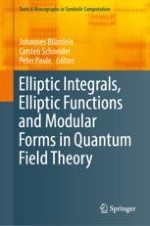2019 | Buch
Elliptic Integrals, Elliptic Functions and Modular Forms in Quantum Field Theory
herausgegeben von: Prof. Dr. Johannes Blümlein, Prof. Dr. Carsten Schneider, Prof. Dr. Peter Paule
Verlag: Springer International Publishing
Buchreihe : Texts & Monographs in Symbolic Computation
